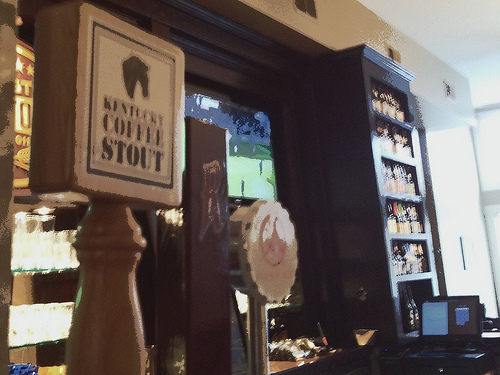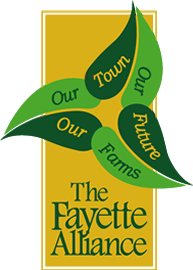Last Wednesday, the Blue Grass Trust deTour to First Presbyterian Church revealed a beautiful sanctuary and other fascinating bits of history. I’ll post soon, but check out this ky360 panorama taken from the rear of the sanctuary of the North Mill Street Church.
On another note, there is a tremendous amount going on right now so posting will be more sporadic and limited for the next few weeks. Blame me… and basketball!
Tag: Fayette
Looking West from Lexington’s Oliver Lewis Way Bridge
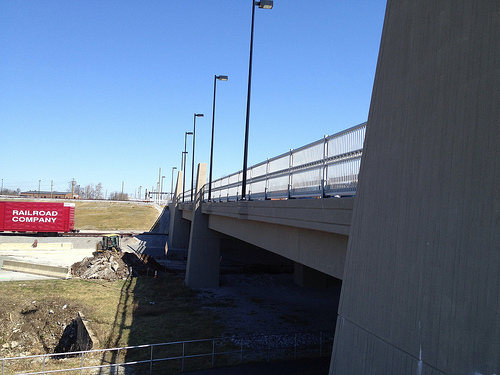 |
| Oliver Lewis Way Bridge – Lexington, Ky. |
At the western edge of the Rupp Arena is the Manchester Street parking lot. This parking lot travels under the Jefferson Street viaduct before coming to an end near the new bridge at Oliver Lewis Way. Although the bridge is rather nondescript, the view from it can be described as anything but.
In Lexington’s never-ending labyrinth of street names, the parking lot was once known by Cox Street because that was the road that extended Newtown Pike from Main Street to High. A rebuilt Newtown Pike Extension was renamed Oliver Lewis Way (slightly west of Cox Street) in time for the 2010 World Equestrian Games. The extension is a fantastic bypass of downtown which I’ve utilized many times, though recently on foot for the first time.
I knew, but hadn’t ever taken the time to notice, all of the activity that occurs on the western side of the bridge:
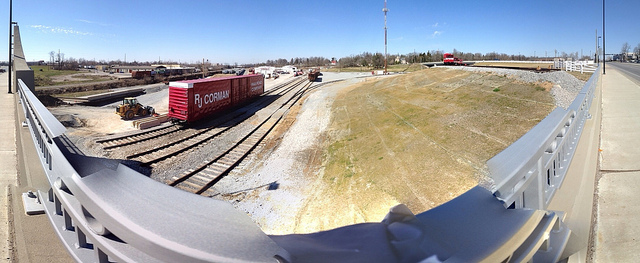 |
| Panoramic View, facing west, from Oliver Lewis Way Bridge – Lexington, Ky. |
All visible are the Distillery District, the Town Branch Creek and the RJ Corman Railyard. About 100 years ago, much of this was open land to receive seasonal flooding of the town branch. The bridge today sits largely over the building and the “s-curve_” in the Town Branch as seen in the 1907-1920 Sanborn Insurance Map below. The building was industrial in nature – the home of the Waller Manufacturing Company, Planing Mill and Hogshead Mfy. A hogshead was a large (225 litre) wooden barrel used typically to hold tobacco or, more importantly given the proximity to several Lexington-based distilleries, to age bourbon.
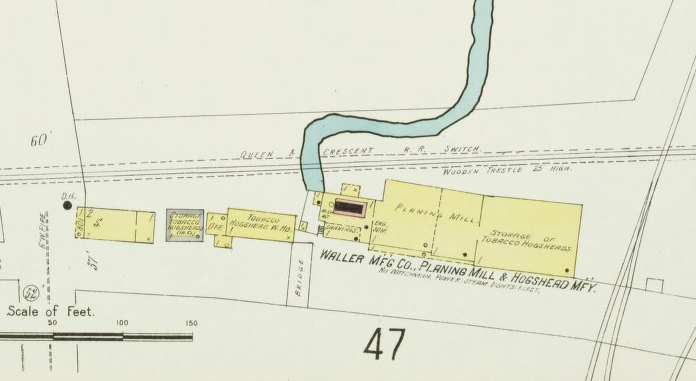 |
| Sanborn Insurance Map (1907-1920); Source: KDL-KYVL. |
The Town Branch Creek which forms the axis on which Lexington is designed flows underneath Lexington (since we buried it). Efforts are underway as part of the Arena, Arts, and Entertainment Taskforce to raise the Town Branch Creek back to the surface. But, looking west from the Oliver Lewis Way Bridge one can already see the Town Branch Creek working its way toward the Kentucky River and beyond:
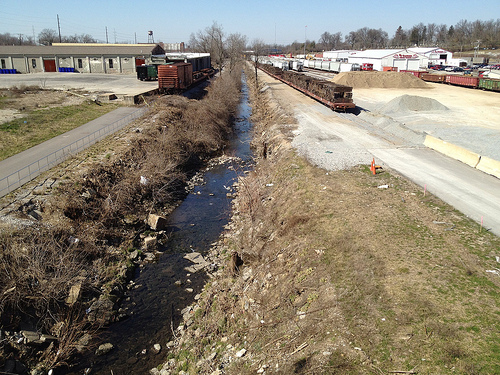 |
| Town Branch Creek – Lexington, Ky. |
Finally, I could spend the afternoon watching the happenings at the RJ Corman Railyard. The coupling and uncoupling of trains and the unloading of freight (often, river sand harvested from near Louisville) is an incredible sight. Corman’s holdings (a lot of land and facilities at its headquarters in Nicholasville, a major derailment division, and the My Old Kentucky Dinner Train among them) all are well-kept and contribute to the beauty of the region. That is something you cannot say about many short lines around the country. Consider the display at the southwest corner of Main and Newtown Streets featuring fence, a stone wall, cab, car and caboose:
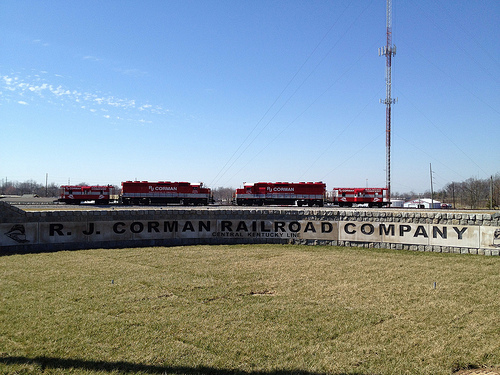 |
| RJ Corman Railyard – Lexington, Ky. |
There is a lot to see from the Oliver Lewis Way Bridge, but you must take the time to observe it. And I’m sure in my few minutes that I missed a lot. What else do you see?
Lexington’s Centrepointe Design Almost a Reality? Feels like it.
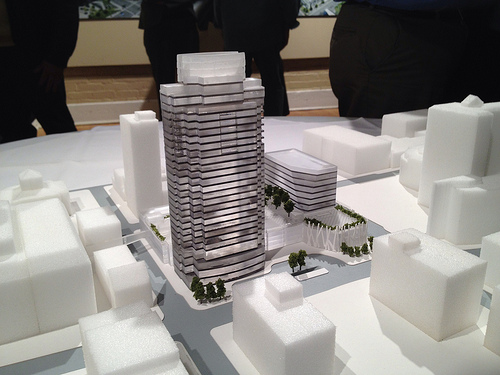 |
| Proposed Design of Centrepointe Block – Lexington, Ky. |
After last night’s public meeting, I am convinced that 2012 will be the year that ground is broken on the Centrepointe project. With the likes of Marriott, Urban Active, Jeff Ruby’s, Saul Good and others being (repeatedly and publicly) linked to the project, it is hard to comprehend that the developers would not be nearing shovel readiness. Yes, ink must be dried, permits and governmental authorizations attained … but by and large, I think we are ready to move forward.
And that will be a good thing. I’ve commented on the Centrepointe saga several times before (here, here, here, and here among others) and I’ve only been a small voice. But the collective voice of many has improved the design of the property from its earliest forms to what we see today.
E pluribus unum. Out of many, one.
Great credit should be given to the property owners for opening up a dialogue about the design of the property even though they have received great criticism. Public comment continued last night at a forum while email comment is being continuously accepted at [email protected].
Great credit should be given to the architects involved – all of them – who have listened to and, as appropriate, incorporated suggestions from the public.
From last night’s public meeting, I did glean a few details about the overall project that were not known last month when the initial renderings of the EOP (the primary architectural firm involved) were released. (See Another Round in the Centrepointe Saga, Feb. 16, 2012) But mostly, these were small details.
In my earlier post, I saw inspiration for the building at Vine and Limestone as being a bird’s nest a la the Beijing Olympic Stadium. Apparently, I was wrong. The building was inspired by a Kentucky forest with its trees strongly reaching upward. The rooftop garden completes the canopy. Okay!?
Anyway, the main thing from yesterday was seeing all the renderings. And there were a lot of them! Here is some of what I saw:








All great! Two notes from these photos. In the second to last, we see a pedway over Upper Street that likely won’t survive the CADRB and I understand that the exact schematics of the pedway are yet to be finalized. We’ll see. More importantly, in the last photo I’m concerned about the vehicular traffic flow into the hotel. It seems that there are some very dangerous points with the up/down ramps as traffic comes in off Vine Street; also, I’m afraid traffic would become congested on Vine as many people arrive for a conference, etc. Just my two cents.
And now for my funny observation of the evening: the schematics indicate that most of downtown is being overrun by either Transy or UK. The Student Center is EVERYWHERE!



Fayette County’s old courthouse is all history
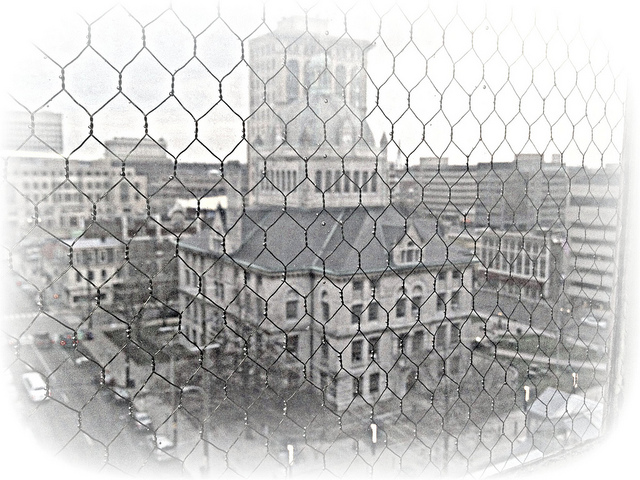 |
| The old Fayette County Courthouse – Lexington, Ky. |
Even before a courthouse first occupied this site, it was an important center of Lexington. In fact, the first schoolhouse in the Commonwealth was built on the site in 1783. It was there that John “Wildcat” McKinney, the schoolteacher, was attacked by and fought off a wildcat that had entered the school.
Fayette County’s first three courthouses were torn down or sold, the fourth burned on May 14, 1897, and the fifth courthouse remains standing on the footprint of its two immediate predecessors. That fire in May 1897 occurred when the courtroom was full of fifth graders taking their year end exam. The smoke and fire caused great calamity throughout the building as adults scurried around with great difficulty and confusion, yet these fifth graders assembled a single file line before safely exiting the building.
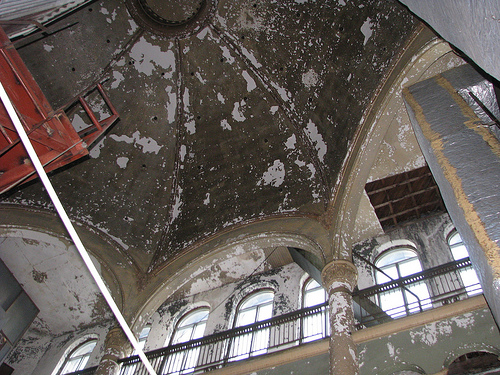 |
| A sneak peek of the HVAC-filled dome |
Visiting the 1898 courthouse is particularly special when the historic dome becomes visible. As written following my 2009 visit to the old courthouse, “Prior to the renovation, visitors inside the courthouse would have marveled at a grand staircase as they gazed up 107 feet to the dome ceiling. The dome, picture above, was painted a blue with dozens of lights which would have illuminated the dome – then one of Lexington’s tallest structures – and the surrounding area. The use of these electric lights in 1900 was groundbreaking; only Paris, France (the “City of Lights”) was using lightbulbs in such innovative ways. The lights would also have illuminated the beautiful interior – the carvings and paintings reminiscent of a 14th century Tibetan palace.”
The 1898 courthouse was designed by the Cleveland, Ohio architecture firm Lehman & Schmitt, who also designed their own city’s Cuyahoga County Courthouse. The Fayette County Courthouse is a fantastic example of Richardsonian Romanesque architecture. In the shape of a Greek cross, though appearing almost cubic, the courthouse has an entrance on each of its four sides. Each entrance is marked by a large round arch and a shallow balcony above. The corbels supporting these balconies feature facing ranging from grotesque to “resembling characters from the Canterbury Tales.”
The clock in the belfry survived the 1897 fire and has been preserved through history to 1806. On the hour, you can still hear the bell mark the hours of the day just as that same bell did for the ears of Henry Clay, John Breckinridge and Abraham Lincoln.
In 1951, plans were moving forward to demolish the 1898 courthouse despite opposition from, as the Lexington Leader called them, “sentimentalists.” The 1951 plan would have transformed the block: “raze the present courthouse; widen Cheapside; build a county building to house businesses, county offices, courtrooms and the county jail at the corner of Cheapside and Short street; put a two-deck parking lot at Short and Upper streets; build a parking garage beneath the county building and the parking lot; sell the jail and the part of the courthouse square that fronts on Main street.” A chief proponent of this new plan was County Commissioner Dudley Burke who, frustrated with the insufficient space in the half-century old structure, wanted “to tear this damn thing down and building a new building.”And although the plan was supported by the chamber of commerce, it ultimately floundered.
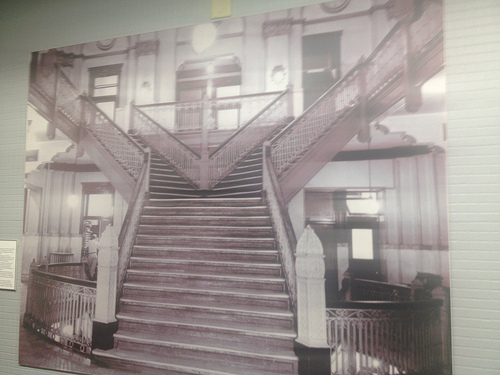 |
| The Old Grand Stairway Remembered |
The space issues, however, did not go away, because five courtrooms had been squeezed into a building designed for one. A 1961 plan called for adaptive reuse. While preserving the façade of the historic courthouse, its inner workings (including the palatial atrium) would be filled with HVAC, an elevator system and restrooms.
A grand jury convened in 1987 focused on the possible solutions to the lack of community interest in the courthouse square which had become to be visibly seen by the growing layers of bird droppings on the lawn’s memorials.
In 2002, the old courthouse closed when the new courthouse complex opened a couple blocks away on North Limestone Street. The old courthouse is the home to several museums, most notably the Lexington History Museum, which opened in 2003. Fundraising is underway to restore the old courthouse to its original glory and provide a beautiful home for these great museums.
Additional photographs are available on flickr.
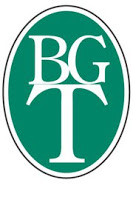
The Blue Grass Trust for Historic Preservation hosts a monthly deTour for young professionals (and the young-at-heart) at a local historic(al) site. Meetings are on the first Wednesday of each month, 5:30 p.m. Details are always available on Facebook! The next meeting is on March 7 at the Henry Clay Law Office and First Presbyterian Church (both on N. Mill between Short and Second Sts.). Click to see Kaintuckeean write-ups on previous deTours.
Sources: kentucky.com; ky120 (Fayette); local.lexpublib.org; NRHP; walkLEX (1st visit)
Only a Park Rose from the Ashes of the Once Mighty Phoenix Hotel
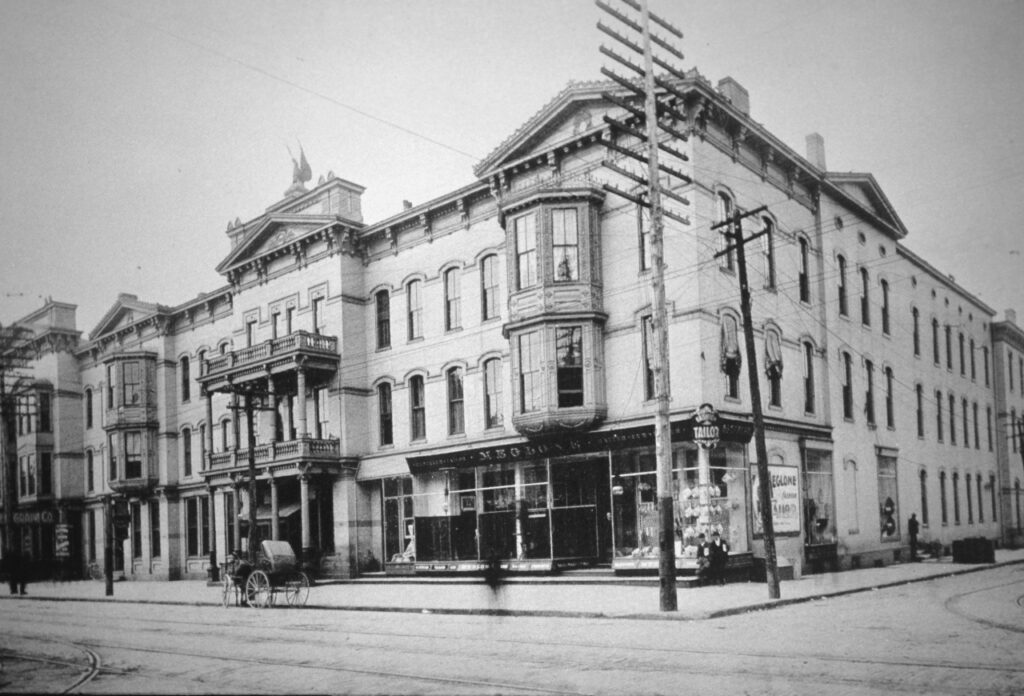 |
| Phoenix Hotel, 1879 Clay Lancaster Collection |
Lexington’s history. Archival photographs juxtaposed with contemporary pictures help to give the clearest
glimpse into Lexington’s history when a building still stands. In those cases where (lamentably) a building has been razed, one’s best sources are research of historic newspapers, books, photographs, and stories.
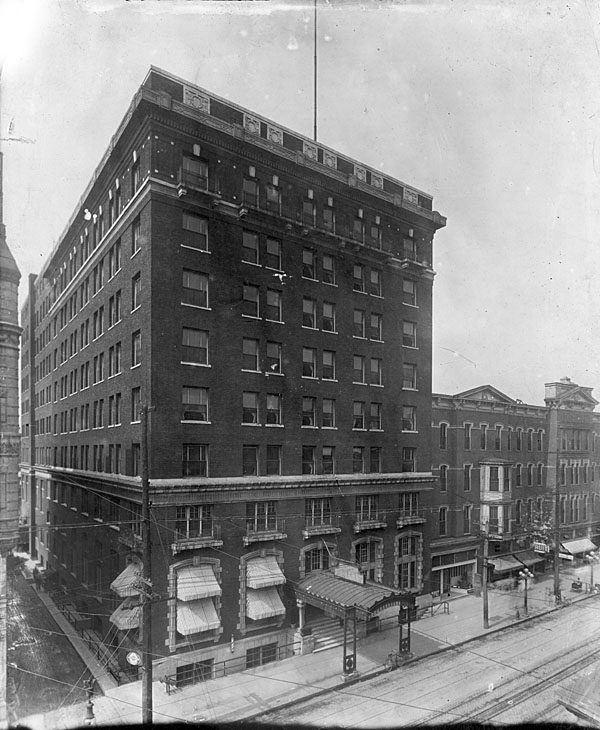 |
| Phoenix Hotel, undated Frank C. Dunn |
stood what was possibly one of Lexington’s most architecturally and historically important buildings: the
Phoenix Hotel. Constructed in 1897 on the footprint of no less than three taverns, the Phoenix
Hotel was established in 1820. Its name was purportedly derived from the hotel surviving a fire in the 1820s.
presidents, the location of the Morgan’s Men Association’s inception (1868),
the Kiwanis Club of Lexington’s inception (1919), and the home of WVLK-AM for
33 years (1947-1980).
taverns (most famously, the Postlethwaite’s Tavern), the Phoenix was quite possibly the longest standing hostelry this side
of the Allegheny Mountains. Its demolition in 1981 ended this reign, making room for the
World Coal Center.
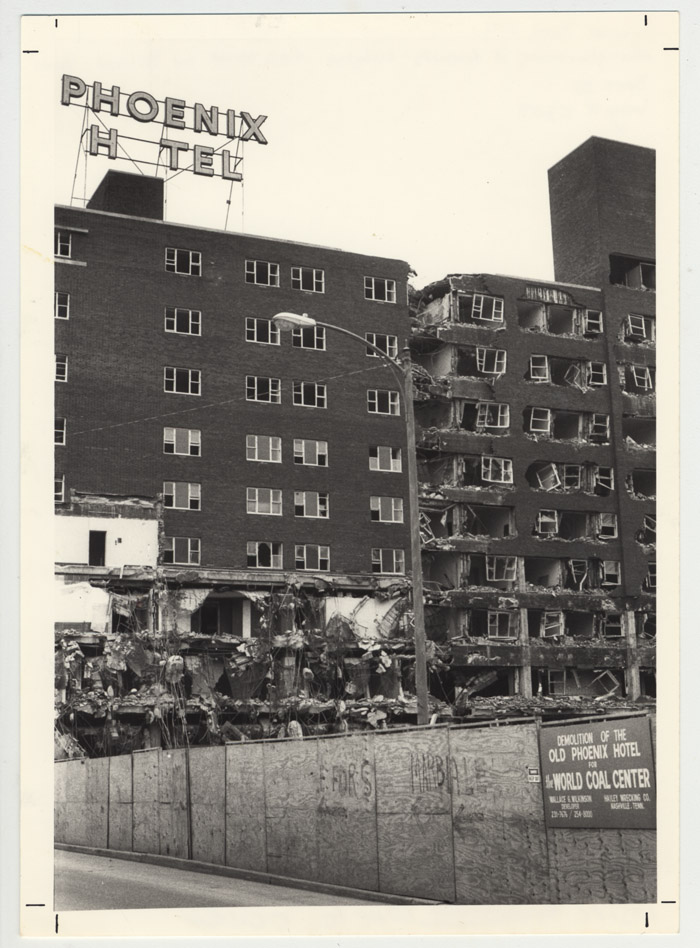 |
| Demolition of the Phoenix Hotel ca. 1981 (note the billboard) Kentuckiana Digital Library |
Conceived by Wallace Wilkinson, later governor from 1987-1991, the World Coal Center (WCC) was to house the corporate headquarters of major coal companies. Depending on the source and plan referenced, the tower was to be 50, 41, or 25 stories beginning with first floor retail space. The demolition of the Phoenix Hotel jumpstarted a statewide discourse on politics,
coal, and preservation.
Despite Kentucky’s coalfields being found in the hills of eastern Kentucky, Wilkinson argued that Lexington was the center of commercial activity for the eastern portion of the state. Building his WCC in the coal fields was not viable. In October 1981,
an op-ed in the Bowling Green Daily News belied Wilkinson’s defense of the coal center suggesting that the choice of location was just “another ‘slap in the face’ to coalfield residents” and that the project would only perpetuate the removal of resources from eastern Kentucky.
The WCC ultimately succumbed to lack of funding. Its shadow hangs over another project that has stumbled from lack of resources: Centrepointe. While the loss of the Phoenix Hotel is thirty years in the rearview of Lexington’s memory, the loss of Morton’s Row is much fresher in the mind of Lexingtonians. The excitement for the Jeanne Gang re-design (combined with disappointment of proceeding without her) and the close eye Lexington keeps on every development demonstrates that some lessons were learned from the loss of the Phoenix Hotel.
Beta Testing and Kentucky Coffee Stout
In software development, there are two basic types of testing: alpha and beta. In alpha testing, you don’t let your product out-of-house as you work out kinks in the system. Beta testing brings the product to the public – or a small subset of the public – for feedback.
I believe Kentucky Coffee Stout is in its own version of beta testing. With much hype on twitter throughout the preceding day, a keg of the first new brew from Alltech’s Lexington Brewing Company was tapped at Lexington Beerworks. A few other locations also have the stout on tap.
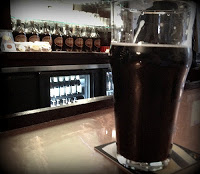 Alltech launched Kentucky Bourbon Barrel Ale in 2006 and this is their first new beer since. Other brews in the lineup are Kentucky Ale and Kentucky Ale Light. I’m a huge fan of all of their beers and was very excited to try Kentucky Coffee Stout so I didn’t tarry on my walk to Lexington Beerworks.
Alltech launched Kentucky Bourbon Barrel Ale in 2006 and this is their first new beer since. Other brews in the lineup are Kentucky Ale and Kentucky Ale Light. I’m a huge fan of all of their beers and was very excited to try Kentucky Coffee Stout so I didn’t tarry on my walk to Lexington Beerworks.
A few sips in, I remembered to snag a photograph. As I talked with the barkeep and a few other patrons, we all had very similar tasting notes. First and foremost, the flavor was great. Starting with a good beer like Kentucky Ale and adding in an excellent coffee bean, Alltech has produced a fantastic flavor.
Flavor is the beer’s strength, but its body is its weakness.
 The coffee beans are from parent company Alltech’s Café Citadelle – a fair trade coffee from Haiti. (Haiti is one of the world’s poorest countries, is located on the western half of Caribbean island Hispaniola, and had a devastating earthquake in 2010 bringing worldwide attention and assistance but has since gone forgotten.) I first tasted Café Citadelle at the 2012 National Horse Show in Lexington (sponsored by Alltech) and found the coffee to be really good. Dumping twelve pounds of the stuff into a batch of beer? Brilliant.
The coffee beans are from parent company Alltech’s Café Citadelle – a fair trade coffee from Haiti. (Haiti is one of the world’s poorest countries, is located on the western half of Caribbean island Hispaniola, and had a devastating earthquake in 2010 bringing worldwide attention and assistance but has since gone forgotten.) I first tasted Café Citadelle at the 2012 National Horse Show in Lexington (sponsored by Alltech) and found the coffee to be really good. Dumping twelve pounds of the stuff into a batch of beer? Brilliant.
The problem with Kentucky Coffee Stout, however, was its body. A sip of a stout beer (think: Guiness, an Irish stout) should leave a slight weight on your tongue. The head on a well-poured stout should occupy about the top inch of the glass, but by the time the Kentucky Coffee Stout hit the bar its head was gone. A slight twirl of the glass left no foam stuck to the side of the glass, again something that should occur in a stout. I can attest that it was not the fault of the barkeep; I’ve already had a few perfectly poured stouts at the Beerworks. This fault, unfortunately, lies with the beer itself. I believe I dubbed it a stout with erectile dysfunction.
It is therefore a question of Shakespearean proportion: would a beer by any other name taste so good? Ignoring the label ‘stout’ for a minute, you’ve got a damn good tasting beer. Dark and flavorful, maybe the texture is purposeful? We’ll find out when this beer leaves beta testing. And it will. Because it is good.
kernel: The Fayette Alliance
The marketing team behind the attempted “Kentucky for Kentucky“, Kentucky for Kentucky, has done a few videos lately that have gotten the attention of the community. One was presented at the final presentation for the Rupp Arena, Arts and Entertainment District plan and the other profiles a local organization, The Fayette Alliance.
I have – and you probably have – seen cars driving around town with a Fayette Alliance bumper sticker. But have you ever wondered more about the organization? I knew they were involved in preserving greenspace and farmland, but the video created over at Bullhorn for the folks at The Fayette Alliance really gives a deeper understanding of an organization committed to making Lexington a “world-class city in our world-class Bluegrass.” Check out the video below:
The Fayette Alliance was founded in 2006 and is headquartered in Lexington’s Historic Western Suburb. Fayette Alliance “has worked with local government to usher over 50 major land-use policies into law that promote farmland preservation and our signature agricultural industries, responsible development, and improved water quality and infrastructure in Fayette County.” On these issues, the Fayette Alliance has created a strong and unified voice on important issues affecting and that will continue to impact Lexington and her future.
Their five pillars reach beyond greenspace because all of Lexington is intertwined. Their five pillars are: creating a dynamic city, protecting our farmlands, helping neighborhoods, cleaning up our streams, and community outreach.
If you are interested in more information on The Fayette Alliance, check out their website.
The Father of the Kentucky Constitution is buried in Lexington
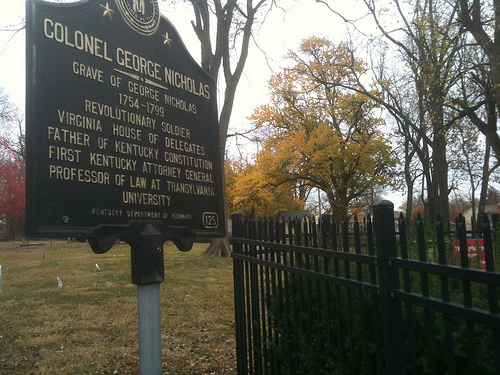 |
| Col. George Nicholas Historic Marker – Lexington, Ky. |
As the wilderness of Kentucky was becoming settled, our collective hero-worship turned from the pioneer to the war hero and statesman. An accomplished Virginia attorney even before he crossed the Appalachians, George Nicholas helped bring Kentucky from wilderness to statehood.
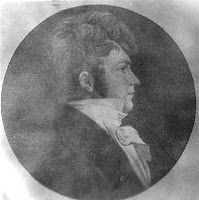 |
| Col. Nicholas from the C. Frank Dunn Collection (KDL) |
For seven years and through nine conventions, Kentuckians had sought statehood independence from Virginia. Now in Danville, Nicholas joined the call. A statehood petition was granted in 1791 and a state constitutional convention was called in April 1792 to prepare a constitution for the new Commonwealth. Five representatives from each of Kentucky’s nine counties came to Danville to accomplish this goal. As one of Kentucky’s leading legal minds, Colonel Nicholas was called upon to serve as chief draftsman of the document. For this, Nicholas is known as the “Father of the Kentucky Constitution.”
A great debate at the constitutional convention arose over the issue of slavery. Nicholas favored slavery and its legal merits, but at least one member of the convention resigned when Nicholas’ draft included language that protected slavery. Found in Article IX of Kentucky’s first constitution, the provisions prohibited the legislature from passing laws “for the emancipation of slaves without the [prior] consent of their owners” and a “full equivalent in money for the slaves so emancipated.” Article IX did at least forbid the “inhumane” treatment of slaves and it also prohibited the commercial slave trade.
Nicholas’ constitution also lacked mention of taxation, education, or a scheme through which to amend the constitution. In today’s Kentucky, this is hard to believe as we face an amendment to our state constitution on almost every visit to the ballot box. These deficiencies and the inability to amend led to calls for a new constitutional convention which was finally convened in 1799; this convention produced Kentucky’s second constitution which was largely based on Nicholas’ work.
On June 15, 1792, Nicholas was appointed by Governor Isaac Shelby to serve as Kentucky’s first attorney general. He stayed in this position for only six months before retiring from public life and to Lexington where he continued to practice law. In 1799, Transylvania University was established as such and with it came the first law school in the west; Colonel Nicholas was appointed as its first law professor.
UK Couple’s engagement during ABC’s Bachelor highlights Lexington
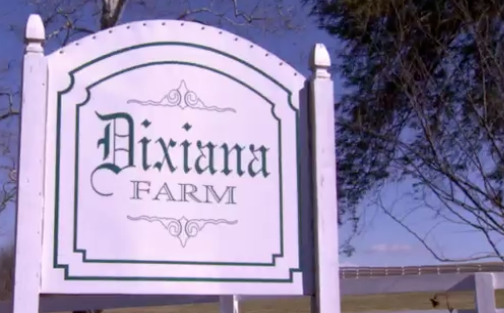 |
| Dixiana Farm – Lexington, Ky. (Photo from Marry Me Monday video) |
On Monday, a Lexington couple’s engagement was the subject of a nationally broadcast commercial during ABC’s The Bachelor. Thanks to a tweet by the University of Kentucky, I knew this was coming making it only somewhat endurable to join my wife in enduring watching this hour of television.
UK alum Brandon Poynter introduced himself as being from Lexington, Kentucky with a photograph on-screen of downtown’s Victorian Square Main Street facade. His proposal to University of Kentucky graduate student Mallory Johnson was the moment of interest in a minute long advertisement by jeweler Jared’s. You can watch his proposal here:
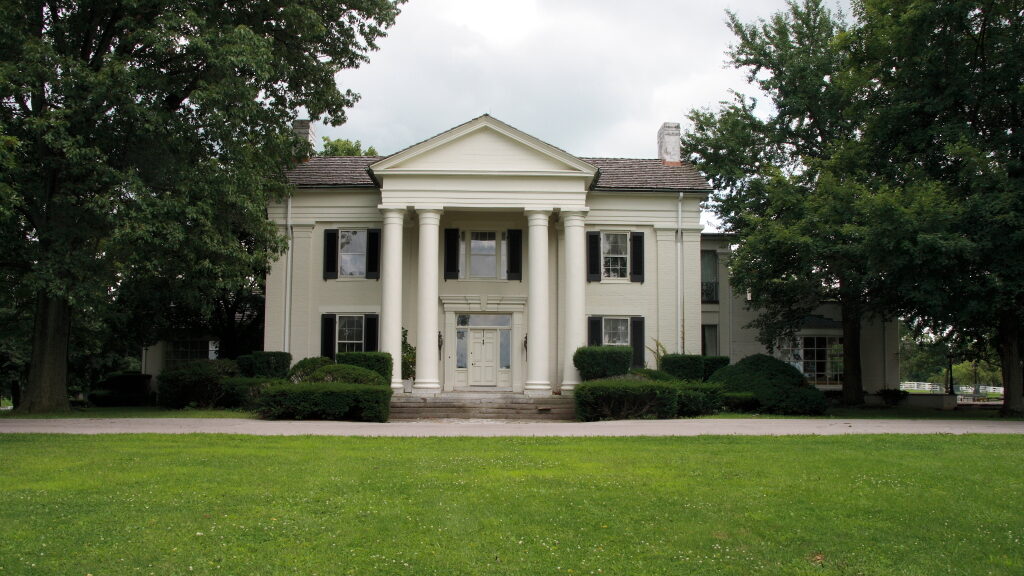 |
| Domino Stud Farm Mansion, since lost to fire (Photo: Dixiana Farms) |
What particularly caught my eye was where Brandon proposed: Dixiana Farm. Located off Russell Cave Road, the farm was the subject of my 2010 post after a major fire devoured one of the farm’s antebellum mansions which is pictured at left. In the 1940s, the great Dixiana Farm was divided into two farms. But the two were reunited in 2009 “putting the historic farm back to its original acreage and name.”
It is always great to see part of Lexington’s beautiful countryside and downtown profiled nationally.
And best wishes to Brandon and Mallory!
ed. note: A revised version updated the photo of the Domino Stud Farm Mansion which was destroyed by the 2010 fire. The original antebellum Dixiana Farm mansion remains standing.
Another Round in the Centrepointe Saga
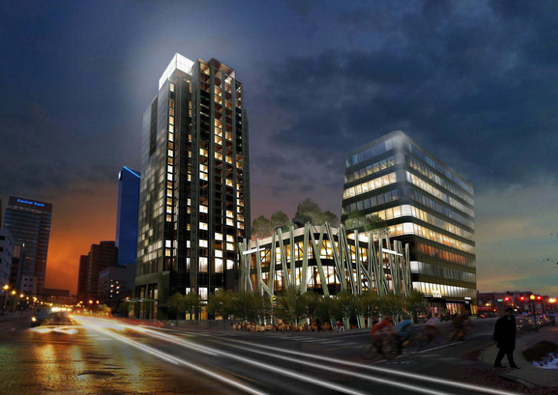 |
| Architect Rendering of Centrepointe from Limestone & Vine (Photo: EOP Architects) |
After the adjournment of yesterday’s Courthouse Area Design Review Board Meeting, the agenda called for a preliminary presentation of the future of the Centrepointe block. With no application previously filed, I think this presentation slipped by everyone (except H-L’s Bev Fortune). This was probably the intent all along: to get feedback from the board prior to having too much information in public hands to be criticized in what has already been a four-year bout among different community stakeholders.
But as a result of this “surprise” presentation, we now have an idea of what is the latest proposal for the block bounded in downtown Lexington by Main, Upper, Vine, and Limestone streets. We will call it, “Centrepointe, version 5.0.”
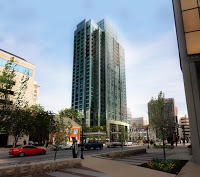 |
| (Photo: EOP Architects) |
The first two proposals by owner and developer the Webb Companies involved a monolithic structure taking the form of either phallus or tombstone. From my perspective, these proposals contained no architectural interest and seemed out-of-scale for downtown Lexington. Later, Webb hired Jeanne Gang from Chicago to create a vision for what could be done with the block. In a disappointing turn of events, Gang was released from the project last October. At that time, Webb announced that EOP Architects of Lexington would take over architectural design.
EOP and Webb incorporated many of Gang’s suggestions and recommendations. Among them is the block’s overall layout, which Gang devised using light and shadow tables: smaller buildings along Main Street, an 8-10 story office tower at Main and Limestone, and the large skyscraper at Upper and Vine.
Kept is the diagonal cut at Main and Limestone into the shorter tower which was intended to create better lines of sight for both pedestrians and drivers. A new feature is the proposed structure at Vine and Limestone: slightly larger than anything under Gang’s proposal, the 3-4 story office building is reminiscent of a more rigid and less natural adaptation of Beijing’s National Stadium (aka, the birds nest). Also retained is the expensive but necessary underground parking.
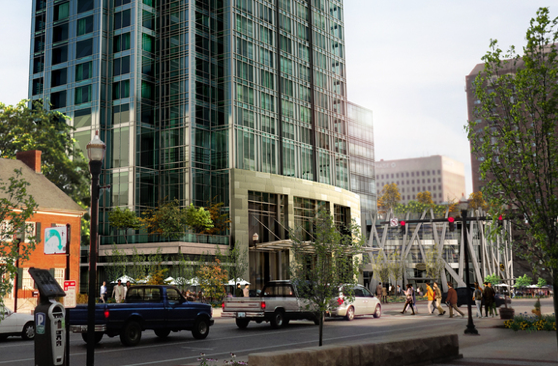 |
| (Photo: EOP Architects) |

